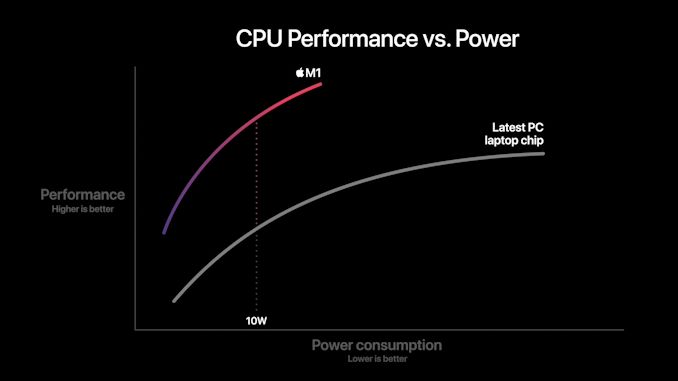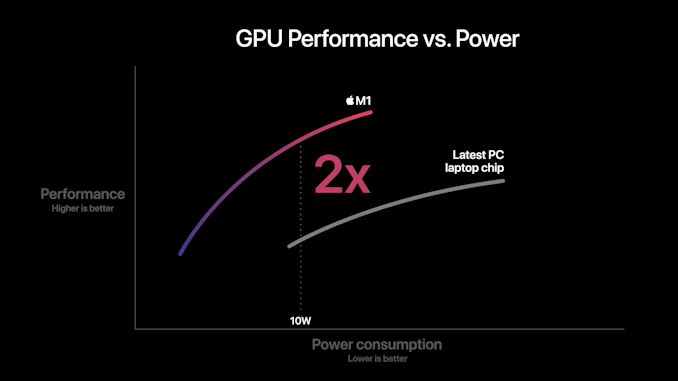Apple Announces The Apple Silicon M1: Ditching x86 - What to Expect, Based on A14
by Andrei Frumusanu on November 10, 2020 3:00 PM EST- Posted in
- Apple
- Apple A14
- Apple Silicon
- Apple M1
Apple Shooting for the Stars: x86 Incumbents Beware
The previous pages were written ahead of Apple officially announcing the new M1 chip. We already saw the A14 performing outstandingly and outperforming the best that Intel has to offer. The new M1 should perform notably above that.
We come back to a few of Apple’s slides during the presentations as to what to expect in terms of performance and efficiency. Particularly the performance/power curves are the most detail that Apple is sharing at this moment in time:
In this graphic, Apple showcases the new M1 chip featuring a CPU power consumption peak of around 18W. The competing PC laptop chip here is peaking at the 35-40W range so certainly these are not single-threaded performance figures, but rather whole-chip multi-threaded performance. We don’t know if this is comparing M1 to an AMD Renoir chip or an Intel ICL or TGL chip, but in both cases the same general verdict applies:
Apple’s usage of a significantly more advanced microarchitecture that offers significant IPC, enabling high performance at low core clocks, allows for significant power efficiency gains versus the incumbent x86 players. The graphic shows that at peak-to-peak, M1 offers around a 40% performance uplift compared to the existing competitive offering, all whilst doing it at 40% of the power consumption.
Apple’s comparison of random performance points is to be criticised, however the 10W measurement point where Apple claims 2.5x the performance does make some sense, as this is the nominal TDP of the chips used in the Intel-based MacBook Air. Again, it’s thanks to the power efficiency characteristics that Apple has been able to achieve in the mobile space that the M1 is promised to showcase such large gains – it certainly matches our A14 data.
Don't forget about the GPU
Today we mostly covered the CPU side of things as that’s where the unprecedented industry shift is happening. However, we shouldn’t forget about the GPU, as the new M1 represents Apple’s first-time introduction of their custom designs into the Mac space.
Apple’s performance and power efficiency claims here are really lacking context as we have no idea what their comparison point is. I won’t try to theorise here as there’s just too many variables at play, and we don’t know enough details.
What we do know is that in the mobile space, Apple is absolutely leading the pack in terms of performance and power efficiency. The last time we tested the A12Z the design was more than able to compete and beat integrated graphics designs. But since then we’ve seen more significant jumps from both AMD and Intel.
Performance Leadership?
Apple claims the M1 to be the fastest CPU in the world. Given our data on the A14, beating all of Intel’s designs, and just falling short of AMD’s newest Zen3 chips – a higher clocked Firestorm above 3GHz, the 50% larger L2 cache, and an unleashed TDP, we can certainly believe Apple and the M1 to be able to achieve that claim.
This moment has been brewing for years now, and the new Apple Silicon is both shocking, but also very much expected. In the coming weeks we’ll be trying to get our hands on the new hardware and verify Apple’s claims.
Intel has stagnated itself out of the market, and has lost a major customer today. AMD has shown lots of progress lately, however it’ll be incredibly hard to catch up to Apple’s power efficiency. If Apple’s performance trajectory continues at this pace, the x86 performance crown might never be regained.












644 Comments
View All Comments
mdriftmeyer - Wednesday, November 11, 2020 - link
Add the Xilinx acquisition with FPGAs for their own Neural Engine, etc., and this wonder by my former employer which I will always support, but not blindly, is just a niche for Consumable laptops that kids and parents will enjoy.GeoffreyA - Thursday, November 12, 2020 - link
And for show in films: it can never be Windows. Always got to be Apple ;)mdriftmeyer - Wednesday, November 11, 2020 - link
FWIW: Apple's GPU is 8 cores and it's M1 CPUs are 4 Big, 4 Little.alysdexia - Wednesday, November 11, 2020 - link
its, hickex2bot - Friday, November 13, 2020 - link
Um, actually, its “‘’it’s’’”alysdexia - Wednesday, November 11, 2020 - link
PCs -> Wintels, DTs; ? isn't a word; big -> great; fast -> swift; optimizes !-> their; "H.W": where'd you learn abbreviations? shit-head; etc -> etc.Sub31 - Friday, November 13, 2020 - link
AMD too had plans for a ARM architecture of their own to go alongside "Zen" back in 2015, but the entire project was probably scrapped (perhaps unsatisfying, not enough money).I can envisage that idea coming back in a few years.
GeoffreyA - Wednesday, November 11, 2020 - link
On the x86/ARM debate, the conversation between mode13_h and deltaFx2 is worth reading:https://www.anandtech.com/comments/16176/amd-zen-3...
GeoffreyA - Wednesday, November 11, 2020 - link
Hope my comment didn't sound hateful against Apple. They're brilliant at their job, but something about them has always put me off.TouchdownTom9 - Wednesday, November 11, 2020 - link
Will be worth seeing if they live up to their claimed numbers or if they are misleading. Will be very interesting to see how these compare to Renior CPUs as well as their Zen 3 successors. Given the node difference, there should be greater efficiency from the M1, but given that the prices for new macbooks (pro/air) have dropped by a few hundred while also now offering the consumer 8 core CPUs, it seems like apple is well on their way to regaining a justifiable claim to having the top premium notebooks on the market. Seems like the x86 to ARM transition was successful--and its pretty crazy how now in 2020 intel is being outclassed by both Apple and AMD in terms of their chips (though it isnt a slaughter when comparing tiger lake on strictly single threaded basis)